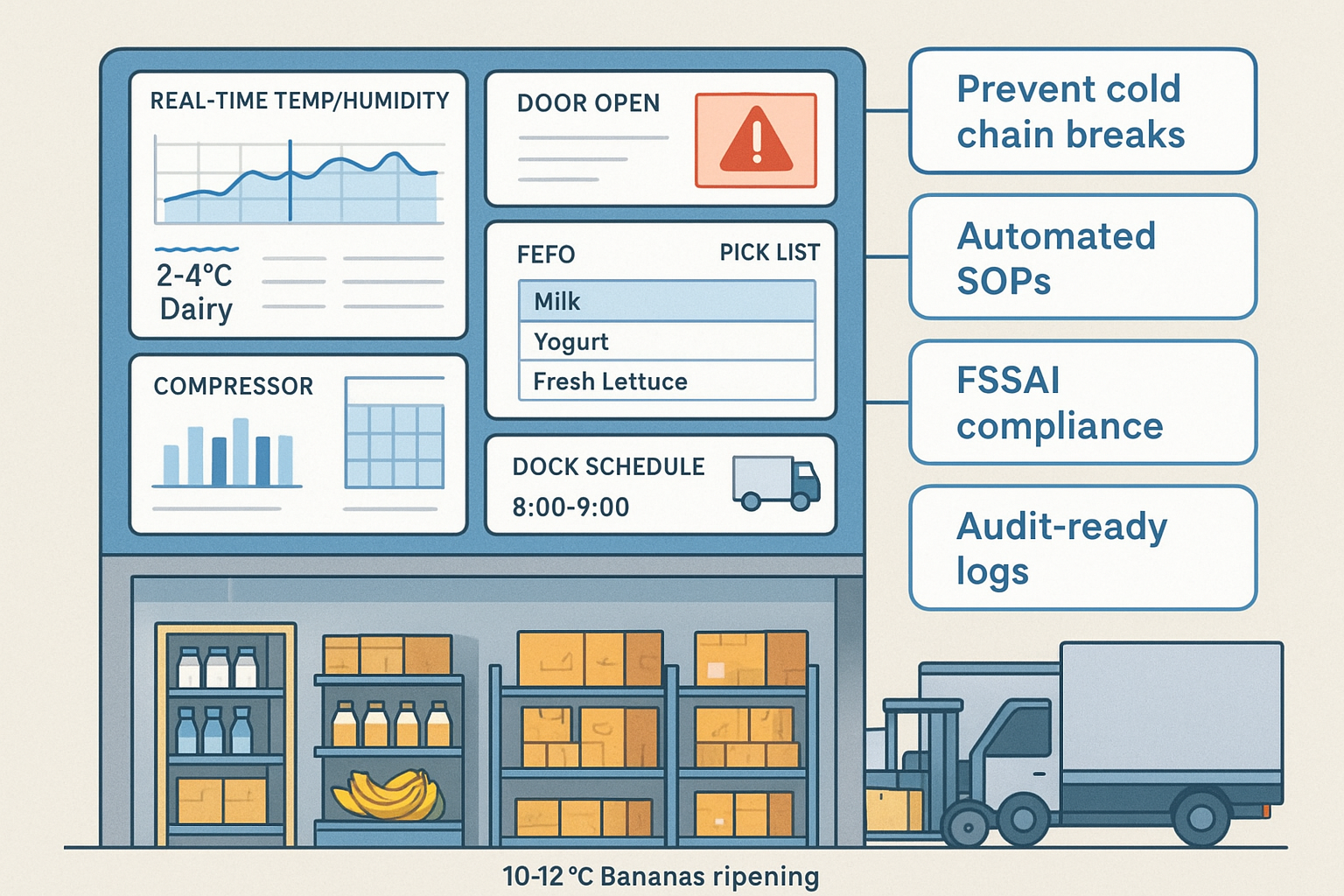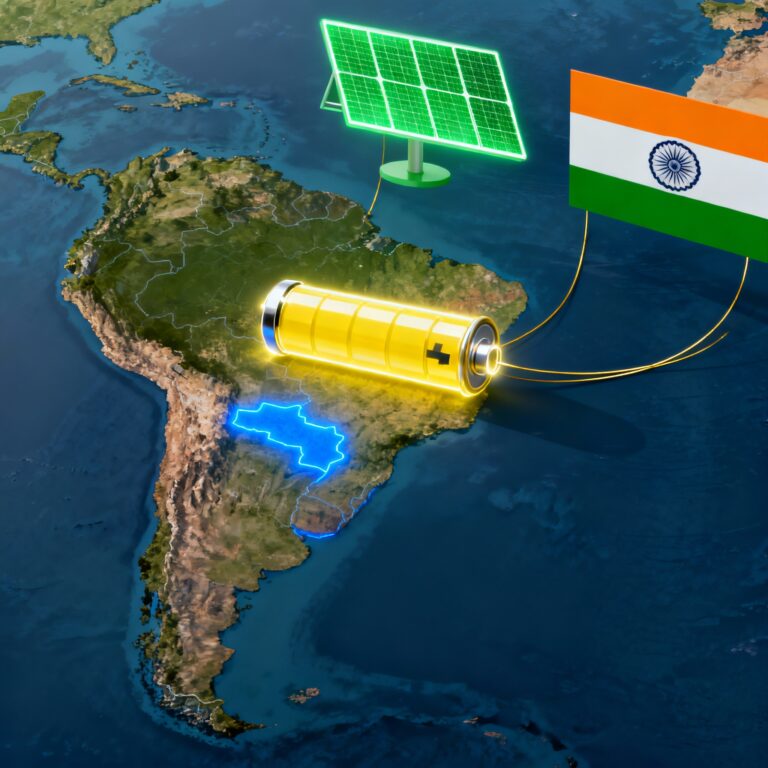Key Highlights
- India loses large volumes post-harvest—especially perishables—due to storage, logistics, and handling gaps, hurting farmer incomes and food security.
- Cold storage capacity reached 395.96 lakh MT across 8,698 units (as of 31 Mar 2024), yet gaps remain vs. assessed needs and perishables’ requirements.
- PMKSY supports integrated cold chains and value addition; hundreds of projects and significant capacity have been added, with continuation till 2026.
- Operation Greens (TOP to TOTAL) provides 50% subsidies on transport and hired storage, stabilizing prices and reducing losses across perishables.
- Smart warehousing (IoT, WMS, automation) and energy-efficient cold chains can sharply cut losses, improve traceability, and expand market access for farmers.
Introduction
Reducing post-harvest losses is one of the fastest ways to raise farmer incomes, stabilize prices, and improve nutrition without expanding cropped area. In India, losses concentrate in perishables—fruits, vegetables, dairy, meat, and fish—due to inadequate pre-cooling, fragmented logistics, and limited cold storage near production clusters. A modern cold chain, paired with smart warehousing, can extend shelf life, reduce distress sales, enable longer market windows, and unlock exports and processing opportunities.
Scale of Losses, Capacity, and Policy Landscape
- Loss magnitude: India loses tens of millions of tonnes annually post-harvest; perishables account for the largest share, driven by gaps in cold storage, pre-cooling, packaging, and logistics.
- Household waste vs. supply chain loss: Globally, food waste is a major emissions source; hotter countries with weaker cold chains see higher losses along the chain, highlighting India’s cold chain imperative.
- Capacity status: As of 31 March 2024, India had 8,698 cold storages with 395.96 lakh MT capacity; earlier assessments projected national requirements of 519.53 lakh MT by 2019–20, indicating persistent gaps and skewed distribution.
- Government push:
- PMKSY (MoFPI) finances integrated cold chains and value addition, agro-processing clusters, preservation capacities, and quality infrastructure; continuation is approved till March 2026.
- Under integrated cold chain components, projects cover pre-cooling, grading, multi-temperature cold rooms, controlled atmosphere, IQF, blast freezing, and reefer logistics; as of 2022, these projects added substantial capacity and are open to FPOs, cooperatives, and private entities.
- Operation Greens, launched in 2018 and later expanded from TOP to TOTAL, provides 50% subsidies on transport and storage hire to stabilize prices and reduce producer losses in perishables.
Analysis: How Cold Chain and Smart Warehousing Raise Farmer Incomes
- Reduce physical and quality loss across the value chain
- Pre-cooling at farm gate and aggregation centers prevents respiration burn and microbial spoilage; CA storage and ripening rooms extend marketable life and maintain quality premiums for fruits and vegetables.
- Reefer transport and cross-docking limit temperature abuse, preserving grade and enabling access to distant markets and processing units.
- Enable price realization and timing
- With storage and longer shelf life, farmers avoid distress sales at harvest peaks, time sales to higher-price windows, and negotiate better contracts with modern retail and processors.
- Operation Greens’ transport and storage subsidies directly reduce logistics costs and buffer price volatility, increasing net realization.
- Expand processing and export readiness
- Cold chains support steady-grade inputs to processors (pulping, freezing, dehydrating), improving plant utilization and farmgate procurement consistency; this can increase offtake from FPOs and contract growers.
- Traceability and quality assurance through smart systems (IoT sensors, WMS, blockchain) meet modern retail/export standards and reduce rejection rates.
- Smart warehousing for efficiency and compliance
- IoT sensors maintain and record temperature/humidity; alerts prevent excursions, while WMS optimizes stock rotation (FEFO), dock scheduling, and inventory accuracy.
- Automation (conveyors, AS/RS), digital checklists, and integrated quality modules lower handling damage, reduce labor errors, and improve compliance with FSSAI and buyer SLAs.
- Climate and sustainability co-benefits
- Food waste contributes materially to GHG emissions; efficient cold chains in hot climates reduce spoilage-related emissions and improve food system resilience.
- Energy-efficient refrigeration, solar-hybrid cold rooms, thermal storage, and insulation upgrades cut operating costs and carbon footprints, supporting long-run viability.
Policy Instruments and Schemes: What to Know
- PMKSY (MoFPI): Umbrella scheme with components including Integrated Cold Chain and Value Addition Infrastructure, Agro-Processing Clusters, Preservation Capacity Expansion, Food Safety Infrastructure, and Operation Greens; extended to March 2026.
- Integrated Cold Chain: Financial assistance up to set limits for end-to-end projects—pre-cooling to reefer vans—open to FPOs, cooperatives, firms, and PSUs; hundreds of projects operationalized; additional cold capacity created nationally.
- Operation Greens (TOP to TOTAL):
Implementation Priorities: A Roadmap
- Cluster-first planning
- Target horticulture clusters (mango, grapes, berries, onions, potatoes), dairy sheds, fisheries hubs, and meat processing belts with integrated pre-cooling, packhouses, and multimodal reefer links.
- Co-locate grading and packhouses with CA/MA storage and ripening; enable last-mile reefer aggregation for FPOs.
- Finance and risk-sharing
- Digital and standards
- Logistics integration
- Outcome tracking
Conclusion
A robust cold chain and smart warehousing ecosystem—anchored by PMKSY and Operation Greens—can transform India’s agri-economy by cutting losses, stabilizing prices, and increasing farmer incomes. The path runs through cluster-based infrastructure, integrated logistics, digital controls, and viable energy-finance models. With capacity gaps still significant, targeted expansion, professional operations, and real-time market linkages can deliver quick wins for farmers while advancing national goals on food security and sustainability.
Exam-Relevant Table: Schemes and Features
Implications for Exams: Sample MCQs and Mains Prompts
- Prelims-type MCQs
- Operation Greens provides a 50% subsidy for transport of eligible crops from surplus clusters to consumption centers and for hiring appropriate storage for up to three months: Correct.
- As of 31 March 2024, India’s cold storage capacity was about 395.96 lakh MT across 8,698 units: Correct.
- The Integrated Cold Chain component under PMKSY supports pre-cooling, grading, CA storage, IQF, and reefer logistics: Correct.
- Mains prompts
- Discuss how cold chain modernization and smart warehousing can reduce post-harvest losses and enhance price realization for farmers, citing PMKSY and Operation Greens.
- Evaluate financing and energy solutions to make rural cold chains viable, including solar-hybrid systems, utilization models, and digital monitoring.
- Assess the role of FPOs in aggregating produce for cold chains and integrating with processing/export markets.









+ There are no comments
Add yours